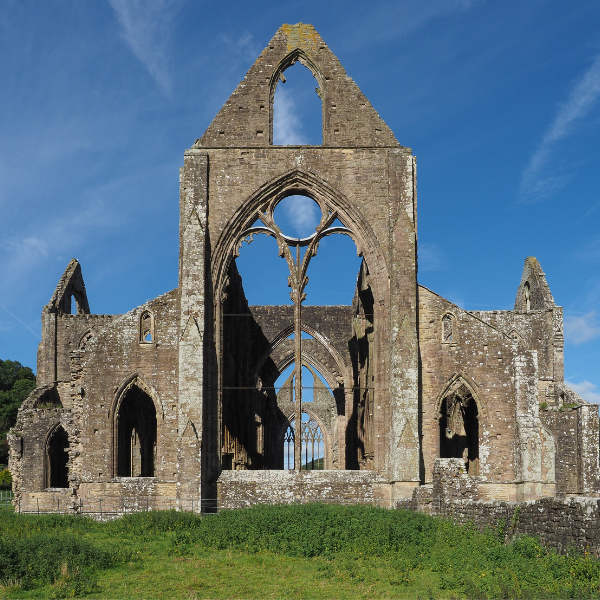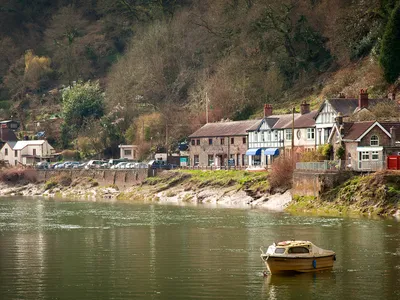Tintern Abbey stands as one of Britain's most captivating medieval ruins, drawing visitors with its soaring arches and serene riverside setting. This magnificent Cistercian abbey offers more than architectural splendour – it's where history, art, and nature converge.

Whether you're planning a visit, researching Welsh heritage, or simply curious about this iconic landmark, this guide covers everything from Tintern Abbey's monastic beginnings to its romantic reimagining and modern-day conservation.
What is Tintern Abbey?
Tintern Abbey is a medieval Cistercian monastery founded in 1131, located in Monmouthshire on the Welsh bank of the River Wye. Its magnificent ruins showcase one of Britain's most complete medieval abbey structures and premier examples of Gothic architecture.
Built from local Old Red Sandstone in varying shades of purple, buff, and grey, the abbey church stretches 228 feet in length with a cruciform design. Now managed by Cadw (Welsh Historic Environment Service), Tintern welcomes approximately 17,000 visitors annually who come to experience its unique blend of spiritual tranquillity and architectural grandeur.
History of Tintern Abbey
Founding of Tintern Abbey
On 9 May 1131, Walter de Clare, Lord of Chepstow, founded Tintern as the first Cistercian house in Wales. He gifted land to monks from L'Aumône Abbey in France who established modest wooden structures, reflecting their order's commitment to austerity and simplicity.
The name "Tintern" itself hints at earlier significance, possibly describing either a farm belonging to someone named Dinerton or a fort on the Derin stream – suggesting the site held importance long before its monastic chapter began.
Early history
The abbey flourished during its first century, gradually replacing wooden structures with stone buildings. By the 13th century, Tintern had become one of Wales' wealthiest monastic houses, which allowed for a complete rebuilding of the abbey church between 1269 and 1301.
Tintern became so successful that it founded two new monasteries – Kingswood in Gloucestershire (1139) and Tintern Parva in Ireland (1203). The Irish foundation came with a dramatic origin story… Earl William Marshal, found himself caught in a violent storm at sea and made a desperate vow to God that he would establish a monastery if he survived. Upon his safe return to land, he kept his promise, inviting monks from Tintern to establish 'Little Tintern' on his Irish estates. Together, these monasteries established a family of Cistercian communities across Britain and Ireland.
Dissolution and ruin
Tintern's fortunes changed dramatically with Henry VIII's Dissolution of the Monasteries. On 3 September 1536, Abbot Wych surrendered the abbey and its estates to the King's visitors, ending 400 years of monastic life.
Valuables were sent to the royal Treasury, the remaining twelve monks pensioned off, and the buildings granted to Henry Somerset, 2nd Earl of Worcester. The lead roof was sold, stone was plundered for local building projects, and nature gradually reclaimed what had been one of Wales' most important spiritual centres.
Tourism in 1800-1900s
The late 18th century saw Tintern's fortunes shift as the Romantic movement sparked new appreciation for picturesque ruins. William Gilpin's ‘Observations on the River Wye’ (1782) and William Wordsworth's famous poem (1798) drew literary tourists eager to experience the emotional response to ruins.
Tourism increased dramatically with improved transportation – the turnpike road completion in 1829 and the Wye Valley Railway arrival in 1876 made day trips from Bristol possible. The village adapted with hotels (including The Royal George, established 1829), tearooms, and shops.
Victorian visitors particularly enjoyed moonlight tours through the ruined church, seeking the atmospheric experiences celebrated in Romantic art and literature.
Tintern Abbey today
In 1901, the Crown purchased Tintern Abbey for £15,000, beginning serious archaeological investigation and conservation work. Now under Cadw's care since 1984, Tintern is Grade I listed with ongoing preservation efforts, including recent work addressing weathered sandstone on the church's upper walls.
Modern visitors can experience the site through guided tours, educational programmes, and special events that bring the history of Tintern to life while preserving the authentic atmosphere that has captivated visitors for centuries.
Artistic inspirations
Poetry
Tintern Abbey's most famous poetic celebration comes in William Wordsworth's ‘Lines Composed a Few Miles above Tintern Abbey’ (1798). Rather than directly describing the abbey, Wordsworth uses it as a powerful symbol in a meditation on memory, nature, and personal growth.
Later poets including Alfred, Lord Tennyson and Allen Ginsberg continued this tradition, demonstrating how the abbey's evocative power spans centuries and literary movements.
Art
J.M.W. Turner created numerous sketches and paintings of Tintern between 1792-1795, capturing the play of light on stone and the romantic atmosphere of the ruins. Other notable artists include Thomas Gainsborough, Thomas Girtin, and Samuel Palmer.
Photography continued this visual tradition, with early photographers like Roger Fenton creating atmospheric studies in the 1850s. Today, Tintern remains one of Cadw's most photographed sites, with visitors continuing to capture its timeless beauty.
Literature
Beyond poetry, Tintern appears in numerous literary works. Jane Austen mentions a Tintern Abbey transparency in ‘Mansfield Park’ (1814), while Charles Heath's ‘Descriptive Accounts of Tintern Abbey’ (first published 1793) ran through eleven editions.
Contemporary literature continues to incorporate Tintern, with historical novels using the abbey as a setting and modern narratives drawing on its atmospheric qualities for inspiration and symbolism.
Film
Tintern's dramatic architecture has made it a natural choice for filmmakers seeking authentic medieval settings. The abbey has appeared in historical documentaries, episodes of ‘Merlin’ and BBC’s ‘Doctor Who,’ and as a backdrop for music videos and fashion photography.
This continuing visual presence ensures that even those who haven't visited can recognise Tintern's iconic arches and windows that have become emblematic of Britain's medieval heritage.
Summary
Tintern Abbey offers a rare combination of architectural splendour, historical significance, and natural beauty that few heritage sites can match. From monastic devotion to romantic ruin to modern conservation project, Tintern continues to evolve while remaining true to its essential character.
Whether drawn by Gothic architecture, literary connections, or simply the tranquil atmosphere where the River Wye meets ancient stone, Tintern Abbey rewards exploration with experiences that linger long after your visit.
Discover Tintern Abbey for yourself and understand why this magnificent structure has inspired visitors for centuries. Book your stay at The Royal George to experience Tintern's heritage firsthand, just steps away from the abbey itself.


